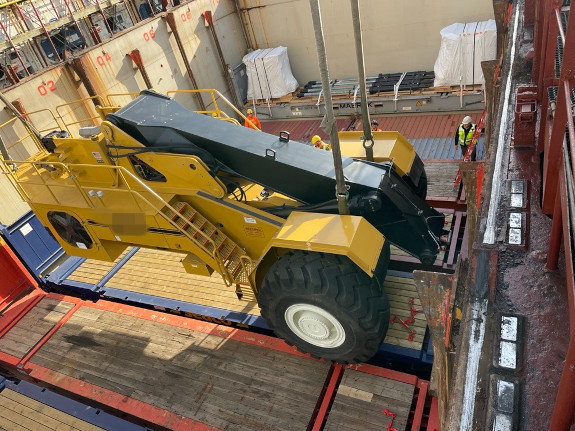Jul 11 | 2025
Former Army Ranger Breaks Down Rapid-Response World of Military Forwarding
.jpg)
By Leslie Meredith
Tyler Sullivan, a U.S. Army Ranger veteran and now EVP of defense solutions at ICAT Logistics, breaks down how the Maryland-based transport specialist keeps critical cargo moving fast and faultlessly, even when global conflict throws trade lanes into chaos.
From Issue 4, 2025 of Breakbulk Magazine
(5-minute read)
“When geopolitical conflicts arise, our team is in motion within hours and on the ground in affected areas shortly thereafter, establishing cross-loading hubs, configuring multimodal routing options, and assessing transit licensing requirements,” says Tyler Sullivan.
“Providing immediate information on which transportation options are available, and which are not, is vital to saving lives and minimizing damage. That kind of response isn’t reactive, it’s immediate, deliberate and engrained in how we operate.”
Sullivan, who is the executive vice president of defense solutions at ICAT Logistics, was describing multiple instances in which, within hours, ICAT issued important updates to defense customers.
“Anywhere in the world, we work to get customers ready within two or three hours of conflict coming to fruition,” he says. “We’re able to do all of the things defense organizations need and share information on what’s happening on the ground to help them pivot as needed.
“We execute in real time while also feeding clients ground-level intelligence to help recalibrate their operations.” Recognizing ICAT’s specialized capabilities, new clients are often able to onboard immediately thanks to the company’s flat operational structure, which eliminates bottlenecks and accelerates decision-making.
“When the world turns volatile, the months of forecasting, demand planning and budget alignment can collapse quite suddenly,” he adds. “That’s when flexible, execution-ready partners aren’t just helpful, they’re critical.”
As a U.S. Army Ranger veteran, I asked him if he saw military logistics in the role of emergency forwarding. He responded, “100%.”
Emergency Freight Forwarding
 “We specialize in high-consequence cargo,” Sullivan explains. “It’s not about what the commodity is, it’s about what happens if it doesn’t move.” Whether it’s a basic part or highly specialized equipment, the urgency stems from the impact of a potential delay or disruption.
“We specialize in high-consequence cargo,” Sullivan explains. “It’s not about what the commodity is, it’s about what happens if it doesn’t move.” Whether it’s a basic part or highly specialized equipment, the urgency stems from the impact of a potential delay or disruption.On the energy side, that might mean a plant or offshore rig offline overseas, costing hundreds of thousands of dollars per day. On the defense side, it could mean troops in the field lacking the gear they need to complete their mission.
“One of our energy clients in Houston called with a rig-down emergency in the Middle East,” Sullivan recalls. “They said, ‘Just get it there now.' Rather than default to a full charter, which would have missed the mark due to permitting delays, the ICAT team sourced a commercial aircraft already en route.”
We delivered the cargo five days sooner than expected and saved them financially in the process,” he says. The result avoided rig-down losses and transportation cost reductions, which are easily as important as budget. "Speed, flexibility and adaptability … that’s what sets us apart,” Sullivan says. “While others are still drafting charter contracts, we’re already executing. In most cases, we’re moving same day, within moments of the first call.”
How Bad Can It Get?
When key shipping corridors close, the ripple effects are immediate and far-reaching. “If you can’t move through the strait into the Red Sea, you’re now forced to reroute around the Cape, adding 14 days of transit time,” Sullivan explains. “That ties up vessels, delays backhauls and puts pressure on other trade lanes where those same ships were supposed to cycle.”
Once ocean freight is underway, options become limited. “You can’t just stop a vessel mid-transit, pull your cargo off and throw it on a plane. Once it’s booked, it’s booked. That container’s not coming off until the vessel arrives,” he says.
For time-sensitive operations, especially in energy, those delays are costly. “If your customer is counting on that cargo to arrive on time, and it doesn’t, they’re not just frustrated, they’re penalized. Every day that material is late, costs them,” Sullivan said.
When Planning Isn’t Enough
He recalls one such client who had followed all the right steps: “They thought, ‘We had the demand planning, the forecasting and everything was mapped out. The shipment was even set to arrive a month early.’ Then suddenly, that was no longer the case.”
Costs began to mount almost immediately. “Insurance premiums spiked, emergency surcharges were applied, and just like that, they were upside down on the deal,” Sullivan explains. “They were being penalized for late performance and faced a tough decision. Either absorb the loss or pass the added costs onto their customer, risking the entire relationship.”
And how long could disruptions like this last? Sullivan doesn’t offer predictions. “It’s nearly impossible to say. I’ve never seen information move this fast,” he says. “When geopolitical intel starts circulating, not shipping updates, but state-to-state political moves, it changes behaviors quickly and unpredictably.”
He points to recent patterns of instability in the Middle East: “Even after cease-fires are announced, incidents can still occur. There are non-state actors and groups that operate independently, and their actions can trigger broader reactions, making a situation unpredictable.”
Which is why, in his view, “there’s almost no way to guarantee that any cease-fire will hold fully.” His advice to defense companies: focus on what’s within their control. “This is where diversifying your carrier base and maintaining close, proactive relationships with your logistics partners becomes critical.”
When flyover rights are revoked, ports shut down, or routes close, “stuff often just gets stuck,” Sullivan says. “When things finally start moving, there’s typically a backlog.”
Larger carriers begin prioritizing higher-margin or contracted business, quickly consuming available capacity and leaving the spot market with limited options. Shippers with smaller volumes or urgent needs often find themselves priced out or pushed aside.
“We protect our customers with everything we have. We don’t want to lose their business, and we don’t want them to lose business,” he says. “When they have a problem, we mobilize immediately.”
Transparency Cuts Both Ways
.jpg) Transparency goes both ways in this type of partnership. When clear and open conversations don’t happen, consequences follow. “If we don’t know what an organization’s priorities are, it’s virtually impossible to know how to prioritize and get creative about a solution, and that’s where we excel beyond most logistics companies.”
Transparency goes both ways in this type of partnership. When clear and open conversations don’t happen, consequences follow. “If we don’t know what an organization’s priorities are, it’s virtually impossible to know how to prioritize and get creative about a solution, and that’s where we excel beyond most logistics companies.”He urges shippers to invest in meaningful relationships with their logistics partners. “Because when the unexpected happens – and it will – you want to be the call they answer first. You want them building solutions they don’t even offer to others.”
He encourages prospective customers to be equally transparent. “Whether you’re a new partner or a long-term one, if there’s no stability, consistent order patterns, or EDI connectivity, then we’re not operating at full alignment,” he says. “The question then becomes, ‘How do we get there? What does it take for us, as the buyer, to earn your attention across all levels of your organization, especially when it matters most?’”
The Outlook: More Demand, More Complexity
Sullivan predicts the military and defense logistics sectors will continue to grow significantly, but shift away from centralized, legacy providers. “I believe we’re going to see a lot more mid-size regional players enter the space,” he says. “Everybody wants to get into what we’re doing because the global landscape is changing, and the demand for agile, high-consequence logistics is only going to rise.”
This decentralization is being driven by geopolitical shifts and a rebalancing of military investment around the world. “As some regions reduce their forward posture in some areas, other nations are ramping up defense spending and investing heavily in domestic manufacturing and supply chain autonomy,” Sullivan explains. “That creates new sourcing patterns, supplier bases and logistical challenges that aren’t going to be solved by the big global players alone.
“The requirement for flexibility, and the ability to respond quickly and effectively as situations unfold, is going to increase substantially,” he says. “We’re already seeing it in the form of higher intake and surge volume from our defense clients. They’re asking for support not just in transport, but in strategy, compliance and coordination on the ground.”
According to Sullivan, this is opening the door for nimble logistics providers who can operate globally but with regional depth: “The opportunity is there for those who can blend speed, compliance and execution without getting bogged down in bureaucracy."
Breakbulk Americas 2025 is taking place on Sep 30-2 Oct in Houston.
Top photo: Tyler Sullivan on the tarmac in Baku, Azerbaijan. Credit: ICAT Logistics
Second: A heavy log stacker being loaded onto a breakbulk vessel for shipment to Europe. Credit: ICAT Logistics
Third: Tyler Sullivan, standing on CH-47 Chinook heavy-lift transport helicopter. Credit: ICAT Logistics
